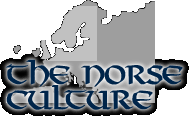 |
|
|
 |
| Norway
is a country of northern Europe located in the western half
of the Scandinavian peninsula. The sea surrounds the northern,
western and southern borders |
 |
|
|
|
of
the country. Only to the east Norway confines with other countries:
Sweden, Finland, and Russia.
Today
4.5 million people live in Norway; nearly
half of the population lives in the far south in the region around Oslo,
the capital.
|
 |
 |
HISTORY
The first people to inhabit Norway were hunters who lived in small
settlements. Gradually, roughly between 1500 and 500 BC, Norwegians
also started to practice agriculture. Around 800 AD, groups of people
living in the south and the west of the region called Vikings started
to move away in search of new land. The name Vikings meant 'men
of the Vik', a huge area that lies between Norway and Sweden. Together
with other groups of Vikings from other regions of Scandinavian
peninsula (Sweden and Denmark), the Norwegian Vikings sailed westward.
They invaded and settled in Ireland, Scotland, England, and France.
They also settled in uninhabited lands such as Greenland and undertook
expeditions as far as the northeast coast of America.
Vikings were skilled sailors and they specialized in building robust
and fast ships for both war and exploration.
In the 11th century, the Vikings established a Scandinavian empire
consisting of England, Denmark and Norway. As the time progressed
the Viking way of life changed. Leading chieftain families accumulated
land and power, trade routes expanded and the first towns were founded.
Also the religion changed; through their expeditions, Viking chiefs
came into contact with Christian monarchies. Olaf II, a Viking chief,
was converted to Christianity and, once back in his country in 1015
he became the king of Norway and brought Christianity to Norway.
In the following centuries Norway became a well-organized and unified
kingdom, until the moment when a plague greatly reduced the Norwegian
population. As a result Denmark and Sweden took the control of the
country and Norway was united with Denmark in 1387, under the queen
Margaret I of Denmark and with Sweden, ten years later.
Norway became a less important part of Scandinavia. The Black Death
and subsequent epidemics provoked a huge loss in the population
which led to the abandonment of farms and deprived the aristocracy
(the Norwegian ruling class) of much of its labor force and hence
of its economic power.
In the following centuries agriculture and wood trade (Norway has
large timber forests) developed again. However Norway remained a
province of Denmark until 1814.
In 1814 Norway was able to obtain independence from Denmark. However,
Norwegian independence got no support from the great powers, and
Sweden attacked Norway. After a very short war, a treaty was signed.
The Swedish crown prince accepted the Norwegian constitution, and
Norway entered the political union with Sweden. The king and foreign
policy was the same for both countries and the Norwegian parliament
took care of national affairs.
In 1905, after several attempts to reach full independence from
Sweden, a settlement was reached: the Swedish-Norwegian union was
dissolved. As a separate realm, Norway stayed free of World War
I but suffered German occupation in World War II. |
|
 |
 |
RELIGION
Nature and natural forces such as fire and cold were important
to the ancient Norse, and were at the root of their mythology. The
world was represented as a great tree (Yggdraisil) with deep roots.
Norse gods and goddesses all had human traits and, like the Greek
gods, they often fought and were victim of violent emotions. They
possessed some magic qualities and unlike most gods in other cultures,
they were not immortal. God and goddesses each had power over their
domains.
The Norse believed that gods could help them against evil forces
but they needed to treat their gods well. To sacrifice a valuable
animal to the gods was a ritual meant to put gods in good mood.
Especially in the Viking age, a rich tradition developed around
the burial of dead people. The dead could not be buried without
burial gifts.
Along with their gods and goddesses, the Norwegians also worshipped
other magical creatures. |
|
 |
 |
SOCIETY,
ECONOMY AND POLITICS
From about the turn of the century, Norway's immense resources of
waterpower, petroleum, fish, forests and minerals provided a base
for great industrial expansion. Today, Norway is a prosperous country
with large-scale enterprises. Many people are employed in manufacturing
is in the engineering industry. Other economic activities are agriculture,
and fishing. Since the beginning of the century the Norwegian governments
have introduced social reforms meant to protect the working population
and to improve working conditions in industry, and agriculture.
Today, about 90 percent of Norwegians belong to the Evangelical
Lutheran National Church, Other religious groups are Roman Catholics,
Methodists, Jehovah's Witnesses, and Baptists. As a result of Asian
immigration, there are also groups of Muslims and Buddhists.
Norway is a constitutional monarchy and its capital is Oslo. With
a popular referendum that was held in 1994 Norway opted to stay
out of the European Union. |
|
 |
 |
CULTURE
The forefathers of the Scandinavian people, the Vikings, were adventurous
seafarers and greatly influenced the Norwegian culture. They flourished
between 800 and the 1100 AD. Although they are often of as violent
raiders, the Vikings were also traders, explorers and settlers.
Behind them they left a legacy not only of archeological remains,
but also of traditions and folk tales.
During the Viking Age, physical strength, speed, resilience and
endurance were considered the most important qualities for men.
Physical competition between men- wrestling, archery, javelin, swimming
or skiing- were common forms of sport. The Vikings also developed
a great ability in metalworking. They built swords, axes spears
and shields that they used in the battle, but also beautiful jewels. |
|
 |
 |
|
|
| "The
Big Myth" © Distant Train 2002 |
